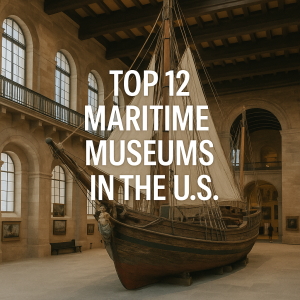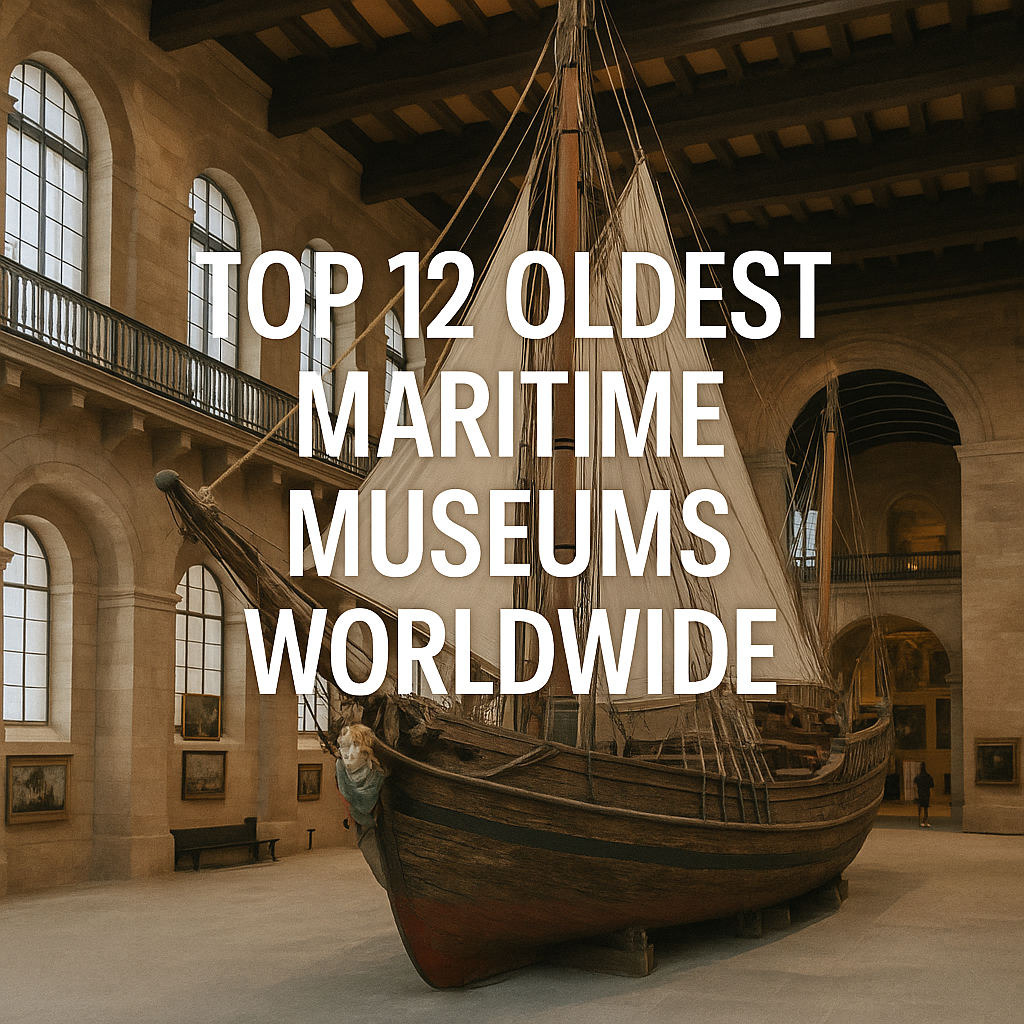Explore the top 12 oldest maritime museums in the world. Discover how these institutions preserve centuries of naval heritage, influence modern maritime education, and inspire global seafaring innovation.

Why Maritime Museums Matter in Modern Maritime Operations
In an age dominated by AI-driven navigation, smart ports, and autonomous vessels, one might wonder: what role do maritime museums play in the ultra-modern world of shipping? The answer is profound. These museums preserve the maritime legacy—centuries of shipbuilding ingenuity, exploration, trade, conflict, and cultural exchange. They act as educational anchors for present and future generations.
According to the International Maritime Organization (IMO), historical context is essential for developing the competencies outlined in the STCW Convention and in advancing Maritime Education and Training (MET). The oldest maritime museums globally provide this foundation by preserving physical vessels, navigational tools, and seafaring stories dating back hundreds of years.
Let’s journey through time and continents to explore the top 12 oldest maritime museums still influencing the maritime world today.
1. National Maritime Museum (Amsterdam, Netherlands) – Opened 1916
Also known as Het Scheepvaartmuseum, this Dutch institution is among the oldest and most respected maritime museums globally. Located in a 17th-century naval storehouse, the museum showcases the Dutch Golden Age of maritime exploration, colonial trade, and naval warfare.
Highlight: A replica of the 1749 VOC ship Amsterdam, symbolizing Dutch East India Company influence on global shipping routes.
Website: hetScheepvaartmuseum.nl
2. National Maritime Museum (Greenwich, UK) – Opened 1937
Home to the Royal Navy’s most significant treasures, the museum is part of the Royal Museums Greenwich. It includes the Royal Observatory and Cutty Sark. The museum interprets naval warfare, oceanic exploration, and British maritime dominance.
Highlight: Admiral Nelson’s uniform from the Battle of Trafalgar and original ship logs.
Website: rmg.co.uk
3. Museu de Marinha (Lisbon, Portugal) – Opened 1863
Commissioned by King Luís I, a naval enthusiast, this museum is one of the world’s oldest dedicated to maritime exploration. Portugal’s legacy as a global maritime empire is on full display—from caravel models to 16th-century astrolabes.
Highlight: Royal barges, nautical charts, and Vasco da Gama-era relics.
Website: museu.marinha.pt
4. Stockholm Maritime Museum (Sweden) – Opened 1938
Housed in a striking neoclassical building, the museum chronicles Sweden’s merchant fleet and naval expansion. It’s known for its Baltic Sea maritime artifacts and ship models that span 300 years.
Highlight: Artifacts from the Swedish East India Company and warship Vasa’s legacy.
Website: sjohistoriska.se
5. Museo Storico Navale (Venice, Italy) – Opened 1919
A hidden gem by the Venetian Arsenal, this museum is steeped in the Republic of Venice’s naval heritage. The maritime empire that once ruled the Mediterranean is vividly illustrated through gondolas, naval charts, and models of galleys.
Highlight: Venice’s Arsenal warship innovation and lagoon-based defense tactics.
Website: museostoriconavale.it
6. Maritime Museum of Barcelona (Spain) – Opened 1936
Located within the Royal Shipyards (Drassanes Reials), this museum explores Spanish naval history and Catalonia’s maritime heritage. It integrates historical shipbuilding practices with modern restoration techniques.
Highlight: Full-scale replica of the 16th-century Royal Galley.
Website: maritim.barcelona
7. Maritime Museum of the Atlantic (Halifax, Canada) – Opened 1948
One of North America’s oldest maritime institutions, the museum features exhibits on North Atlantic seafaring, including the Titanic and Halifax Explosion.
Highlight: Titanic artifacts and the story of Samuel Cunard.
Website: maritimemuseum.novascotia.ca
8. Maritime Museum (Istanbul, Turkey) – Opened 1897
Founded during the Ottoman Empire, it holds rare artifacts from the era of the sultans and the rise of Turkish naval power in the Mediterranean. It’s operated by the Turkish Navy and has extensive collections on Islamic maritime traditions.
Highlight: Imperial Caiques—ornate sultan boats over 30 meters long.
Website: denizmuzesi.dzkk.tsk.tr
9. Australian National Maritime Museum (Sydney, Australia) – Conceptualized 1900s, opened 1991
While its formal inauguration was in 1991, the institution stems from Australian Federation-era maritime exhibits. It presents the evolution of Australia’s naval power, indigenous maritime traditions, and immigrant shipping stories.
Highlight: The retired HMAS Vampire and replica of HMB Endeavour.
Website: sea.museum
10. Deutsches Schiffahrtsmuseum (Bremerhaven, Germany) – Opened 1975 (roots in 1900s)
Though officially launched in 1975, its collections began in the early 20th century. It provides a critical lens on German naval history, shipbuilding science, and maritime trade through World War eras.
Highlight: Bremer Kogge, a 14th-century shipwreck reconstruction.
Website: dsm.museum
11. National Maritime Museum (Galle, Sri Lanka) – Opened 1992 (within 17th-century Dutch warehouse)
Built within a colonial Dutch warehouse dating back to 1671, the museum embodies the Indian Ocean’s importance in spice trade and naval colonialism. Artifacts relate to both European and South Asian seafaring traditions.
Highlight: Ancient navigational instruments and maritime silk road exhibits.
Website: srilankatravelandtourism.com
12. Hong Kong Maritime Museum – Opened 2005 (but based on century-old archives)
Though newer, its collections trace back to archives from the British colonial maritime offices and Chinese merchant guilds, making it a crucial node in East Asian maritime education.
Highlight: Maritime silk route exhibits and Chinese junk replicas.
Website: hkmaritimemuseum.org
–
Case Study: Royal Museums Greenwich – A Legacy of Scientific Navigation
The Greenwich complex—including the Royal Observatory and Cutty Sark—has shaped global navigation since the 17th century. Its role in developing Greenwich Mean Time (GMT) and celestial navigation echoes in today’s GPS systems. As a cultural anchor, it integrates history, science, and global coordination—principles that modern ship route optimization and Inmarsat systems still follow.
FAQs
1. Why are these museums relevant to modern shipping?
They offer historical insights that enrich current practices in ship design, safety, and sustainability. Institutions like RINA and Lloyd’s Register often collaborate with museums on heritage conservation and naval architecture archives.
2. Are these museums involved in maritime education?
Yes. Many partner with maritime academies and IMO-backed MET initiatives, providing experiential learning and historic case studies.
3. Can digital exhibits replace physical visits?
Digital access is growing, especially post-COVID-19, but real-world ship models, materials, and scale cannot be replicated virtually in full.
4. Are these museums funded by governments or private donors?
Funding varies. Some are state-run (e.g., UK’s National Maritime Museum), while others rely on maritime foundations or shipping magnates.
5. Do museums contribute to environmental awareness?
Absolutely. Many now feature climate change exhibits, decarbonization efforts, and marine conservation in line with IMO 2020 and COP26 goals.
6. What’s the role of class societies in maritime museum preservation?
Entities like DNV and ABS often provide technical guidance in restoring historic ships and modeling marine corrosion or hydrodynamics.
7. How can cadets benefit from museum visits?
Cadets can contextualize textbook theory with real-world artifacts, like hull forms, navigation tools, and propulsion systems.
Conclusion
The world’s oldest maritime museums are not relics of a bygone era—they are active participants in shaping maritime education, heritage conservation, and even policy development. In a time of rapid change, from AI in logistics to green shipping fuels, these museums remind us of the industry’s enduring traditions, challenges overcome, and the human stories behind every hull.
Call to Action:
Whether you’re charting a professional course or setting sail on academic discovery, these museums offer rich troves of wisdom. Visit in person, explore their digital archives, or consider supporting their preservation missions.
References
-
International Maritime Organization (IMO). www.imo.org
-
Royal Museums Greenwich. https://www.rmg.co.uk
-
Museu de Marinha. https://museu.marinha.pt
-
National Maritime Museum Amsterdam. https://www.hetscheepvaartmuseum.nl
-
Australian National Maritime Museum. https://www.sea.museum
-
Deutsches Schiffahrtsmuseum. https://www.dsm.museum
-
Stockholm Maritime Museum. https://www.sjohistoriska.se
-
MarineTraffic. https://www.marinetraffic.com
-
Journal of the Royal Institution of Naval Architects (RINA). https://www.rina.org.uk
-
UNCTAD. https://unctad.org

